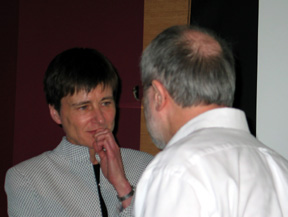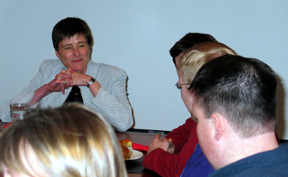 |
Catherine Verfaillie, M.D., and Angie Rizzino, Ph.D., discuss stem cell research after her presentation in the Durham Research Center Auditorium. |
A pioneer of stem cell research, Dr. Verfaillie (pronounced ver-FI) was in Omaha Tuesday to present the 23rd Annual Latta Lecture at UNMC. She is the director of the University of Minnesota’s Stem Cell Institute.
“It’s too early to decide if one or the other is better,” said Dr. Verfaillie, who is best known for her work in adult stem cells. “There is sufficient difference between the two stem cells, so both should be looked at side-by-side.”
Stem cell research — embryonic and adult – allows for extensive study of human diseases in the lab, not only in people and mice. Ultimately, what scientists learn from each area will benefit the other, Dr. Verfaillie said.
“As scientists we have to go after the truth and get the facts,” she said.
The focus on stem cell research is relatively recent, Dr. Verfaillie said, noting that Science magazine proclaimed stem cells the “breakthrough of the year” in December 1999, after researchers announced they had managed to keep embryonic and fetal human cells at their maximum potential, ready to be steered into becoming any cell in the body.
 |
Catherine Verfaillie, M.D., meets with UNMC graduate students. |
But, stem cell research has its critics, as other biomedical breakthroughs did historically, Dr. Verfaillie said.
Heart transplantation initially was vilified when Dr. Christiaan Barnard first did it in Cape Town, South Africa, in December 1967. “It was considered blasphemy to take the heart and soul out of one person and put it into another,” Dr. Verfaillie said.
The ability to isolate DNA also had early opponents, she said.
In 2000, Dr. Verfaillie was named one of the nation’s 10 leading innovators in science and technology by the U.S. News and World Report. Earlier this year, she announced her plans to step down from her position at the University of Minnesota to oversee the creation of a similar institute in Belgium, her native country. She will divide her time over the next two years between the two institutes.
Stem cell research is more widely accepted in Europe than genetically engineered foods, Dr. Verfaillie said, while in the United States the reverse is true.
There is excitement about adult stem cells because they may be more potent than previously thought, Dr. Verfaillie said. In addition, they already are being used for therapy, can be obtained from autologous sources and are an adult source of cells. Still, there are many studies not yet confirmed, she said, and the mechanism is not understood.
Meanwhile, embryonic stem cells do not senesce (grow old), are pluripotent (can develop into any of the three major tissue types), may be used to treat many diseases and can be used as a model for disease. Still, there are scientific and ethical hurdles to overcome because they are allogeneic and involve the destruction of the blastocyst.
Universities that do not get involved in stem cell research will miss out on a huge area of biomedical research, Dr. Verfaillie said, including potential drug development.
“I can’t be too optimistic that stem cell research will cure everything, but in the next 10 to 20 years it will change what we know about diseases and how we treat them,” Dr. Verfaillie said.
Meanwhile, both areas of study should continue, Dr. Verfaillie said. “There are too many basic questions unanswered to decide to date that either adult or embryonic stem cells will be clinically suitable,” she said. “It’s possible, if not likely, that embryonic stem cells may be a better source for tissue no. 1, whereas adult cells may be better for tissue no. 2.”